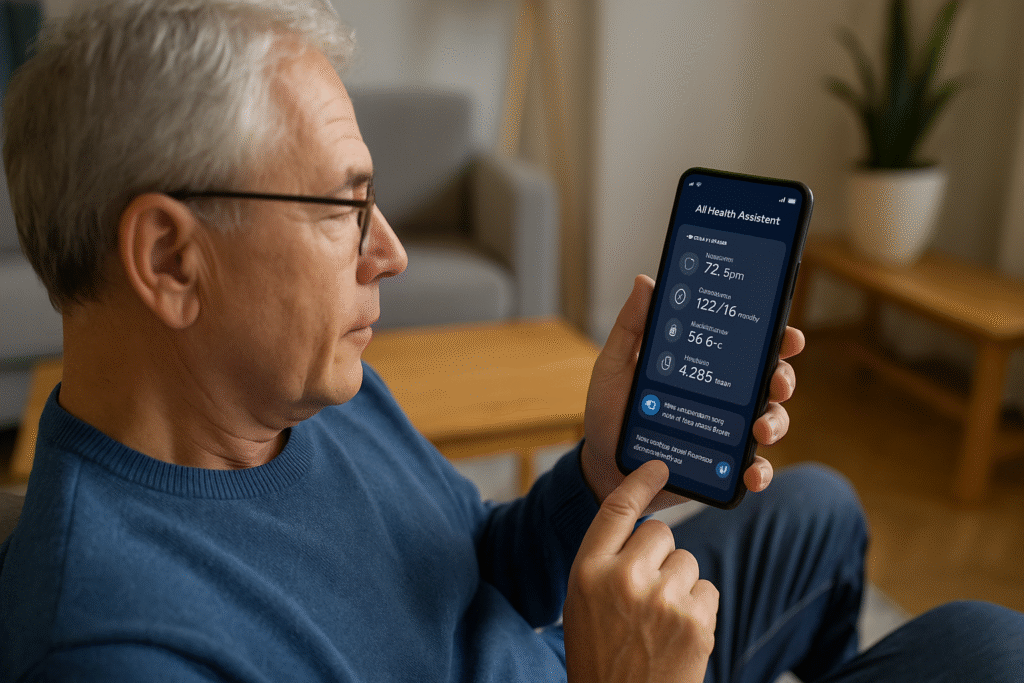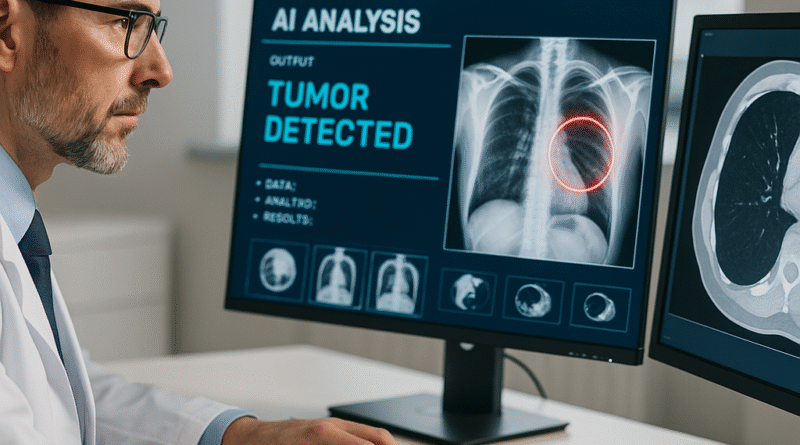5 Powerful Ways AI Is Fighting Cancer in Europe
AI is Fighting Cancer Introduction: A New Ally in the War on Cancer
Cancer has long stood as one of Europe’s most complex and heartbreaking healthcare battles. Despite decades of investment in research, pharmaceutical innovation, and public health campaigns, cancer remains the second leading cause of death across the European Union, claiming over 1.3 million lives annually.¹ Explore full cancer statistics from the ECIS. Behind those numbers are families disrupted, careers paused, and healthcare systems stretched thin.
In recent years, European nations have made substantial strides in treatment innovation. From immunotherapies to minimally invasive surgical techniques, the tools to combat cancer are growing more sophisticated. Yet, critical gaps persist, especially in early detection, diagnostic speed, personalized treatment plans, and post-treatment monitoring. In rural regions or resource-constrained hospitals, these challenges are even more pronounced.
Enter artificial intelligence.
In 2025, AI is no longer a theoretical buzzword confined to research labs and tech summits. It is now an operational force embedded in clinics, hospitals, and cancer centers throughout Europe, augmenting human expertise and accelerating progress in ways previously unimaginable. What was once considered “futuristic” is now part of standard workflows in radiology departments in Germany, pathology labs in Sweden, and chemotherapy units in Italy.
This isn’t about replacing doctors with machines. It’s about equipping healthcare professionals with smarter tools, tools that can detect microscopic anomalies in scans faster than the human eye, map out individualized drug regimens based on a patient’s genetic profile, and even predict complications before they become life-threatening emergencies. AI isn’t just helping with physical illness, it’s transforming mental health too.
The integration of AI into oncology is not only about speed and accuracy; it’s also about equity. By democratizing access to expert-level diagnostics and decision-making support, AI helps bridge the urban-rural healthcare divide, reduce wait times, and expand access to world-class cancer care for every patient, regardless of geography or background.
This article explores five powerful ways AI is actively transforming cancer care across Europe, from how we detect tumors to how we monitor recovery. These advances aren’t just promising. They’re already in motion, reshaping the reality of cancer treatment, improving survival rates, and most importantly, restoring hope to millions.
Whether you’re a policymaker, a medical professional, a patient advocate, or someone who has been personally touched by cancer, understanding how AI is changing the game isn’t just informative, it’s essential. Because in this new era of medicine, AI isn’t on the sidelines. It’s becoming one of the most important allies we have in the fight against one of humanity’s toughest diseases.
Table of Contents
Why It Matters
In Europe, cancer is the second leading cause of death, accounting for 1.3 million deaths annually.¹ With an aging population and growing healthcare demands, traditional systems alone can’t keep up. AI offers a scalable, data-driven solution that can improve care while reducing strain on overburdened health systems.
Importantly, AI isn’t replacing doctors, it’s enhancing their abilities. It finds patterns humans can’t, processes millions of data points in seconds, and helps clinicians make more confident, personalized decisions. The result? Better survival rates, faster diagnoses, and smarter use of resources.
1. AI Is Revolutionizing Cancer Detection with Medical Imaging
What’s happening: AI algorithms are being trained to read mammograms, CT scans, and MRIs, spotting anomalies faster and with greater accuracy than even expert radiologists in some cases.
Where it’s being used:
- The UK’s National Health Service (NHS) is piloting AI tools to reduce wait times for cancer scans.
- In Germany, researchers at Charité Berlin are using AI models to detect lung cancer nodules earlier than traditional scans allow.
Why it matters:
Early detection is critical. A tumor found at stage 1 can often be treated successfully, while a stage 4 diagnosis may come too late. AI enables mass screenings at scale, catching cancers earlier, especially in underserved regions with limited radiologist access.
Example: Google Health’s AI system was shown to outperform human radiologists in detecting breast cancer in a UK-US study², potentially saving thousands of lives through earlier diagnosis.
Read the full study published in Nature.
2. AI Is Powering Personalized Cancer Treatment Plans
What’s happening: AI helps oncologists tailor treatments by analyzing genetics, lifestyle, and clinical history, creating highly individualized care plans.
Where it’s being used:
- Gustave Roussy Institute in France uses AI to match cancer patients to personalized drug regimens and clinical trials.
- Finland’s FIMM Institute deploys AI to combine genome sequencing and machine learning for rare cancers.
Why it matters:
No two cancers, or patients, are exactly the same. By using AI to process massive datasets from electronic health records (EHRs), pathology reports, and genetic markers, doctors can avoid the “one-size-fits-all” model and instead deliver therapies with higher success rates and fewer side effects.
Example: IBM Watson for Oncology helped match over 1,000 cancer patients to precision therapies at European partner hospitals, reducing trial-and-error treatment paths.³
3. AI Is Accelerating Drug Discovery and Clinical Trials
What’s happening: AI speeds up the process of identifying potential cancer-fighting compounds and predicting how they will work, cutting years off traditional drug development timelines.
Where it’s being used:
- British biotech company BenevolentAI uses machine learning to identify potential oncology drug targets.
- BioNTech (Germany), known for its COVID-19 vaccine, is applying AI to accelerate personalized cancer immunotherapies.
Why it matters:
Traditional drug discovery is slow, expensive, and uncertain. AI reduces failure rates by predicting toxicity, success probabilities, and patient responses, enabling more agile clinical trial design.
Example: In the UK, AI shortened a candidate drug discovery cycle from five years to 12 months for a type of liver cancer.⁴
4. AI Is Supporting Pathologists with Faster, Smarter Diagnostics
What’s happening: AI tools now assist in analyzing biopsies and tumor samples, flagging malignant cells and grading cancer severity in a fraction of the time.
Where it’s being used:
- At the University of Oxford, PathAI models are used to assist pathologists in grading prostate cancer.
- Swedish startup Ibex Medical Analytics is working with hospitals to implement AI-driven digital pathology across Europe.
Why it matters:
Pathologists face a global shortage and often have high caseloads. AI can pre-screen, flag high-risk cases, and reduce diagnostic variability, helping doctors focus where it’s needed most.
Example: A study published in The Lancet showed that AI-assisted diagnosis increased accuracy in prostate cancer biopsy grading by 12%.⁵
5. AI Is Enhancing Patient Monitoring and Predicting Outcomes

What’s happening: AI models analyze patient behavior, wearable data, and symptom trackers to monitor recovery and predict complications in real time.
Where it’s being used:
- In Denmark, hospitals are testing AI platforms to monitor chemotherapy patients remotely, alerting staff to early signs of adverse reactions.
- In Italy, AI-powered chatbots are helping oncology nurses triage symptoms and offer emotional support.
Why it matters:
Continuous monitoring helps catch complications early, before they escalate. AI also supports patients between appointments, especially in rural or resource-limited areas.
Example: In a Spanish pilot, AI-enabled apps reduced emergency readmissions by 24% among cancer patients receiving outpatient care.⁶
FAQ: AI and Cancer in Europe
Q1: Is AI replacing doctors in cancer care?
No. AI is a support tool, not a substitute. Doctors still make the final decisions but with more data and insight at their fingertips.
Q2: How does AI protect patient data?
Strict GDPR compliance in Europe ensures patient privacy. Most AI systems use anonymized data and operate within regulated healthcare environments.
Q3: Can AI be trusted with life-or-death decisions?
AI is only as reliable as its training data and supervision. In Europe, AI is used to assist, not autonomously treat, and every system undergoes clinical validation before deployment.
Learn how ethical frameworks are shaping responsible AI use in healthcare.
Q4: Will these AI tools be available in all EU countries?
Availability depends on funding, infrastructure, and policy. However, many EU-backed initiatives aim to make AI tools accessible across member states.
Q5: How can patients benefit directly from AI in cancer care?
Faster diagnosis, more accurate treatments, fewer hospital visits, better monitoring, and access to cutting-edge therapies, all powered by AI-enhanced healthcare.
Final Thoughts: A Smarter Fight, A Brighter Future
Europe’s fight against cancer is entering a new era, one where artificial intelligence isn’t just assisting doctors but reshaping the battlefield. From early detection to drug discovery, AI is helping reduce delays, personalize care, and bring precision to a disease long known for its unpredictability.
But success won’t come from AI alone. It will require collaboration, between technologists, healthcare workers, policymakers, and patients. It will require strong ethical guidelines, equity in access, and ongoing research.
Still, the promise is real. With AI as a powerful ally, AI isn’t just for hospitals, these tools can help you improve clarity and decision-making. Europe stands a better chance than ever before of turning cancer from a crisis into a challenge we can meet, with speed, intelligence, and compassion.
Sources:
¹ European Cancer Information System (ECIS), 2024
² McKinney SM et al., Nature, 2020
³ IBM Research & Manipal Hospitals, 2023
⁴ BenevolentAI press release, 2024
⁵ The Lancet Digital Health, 2023
⁶ European Journal of Cancer Care, 2024
